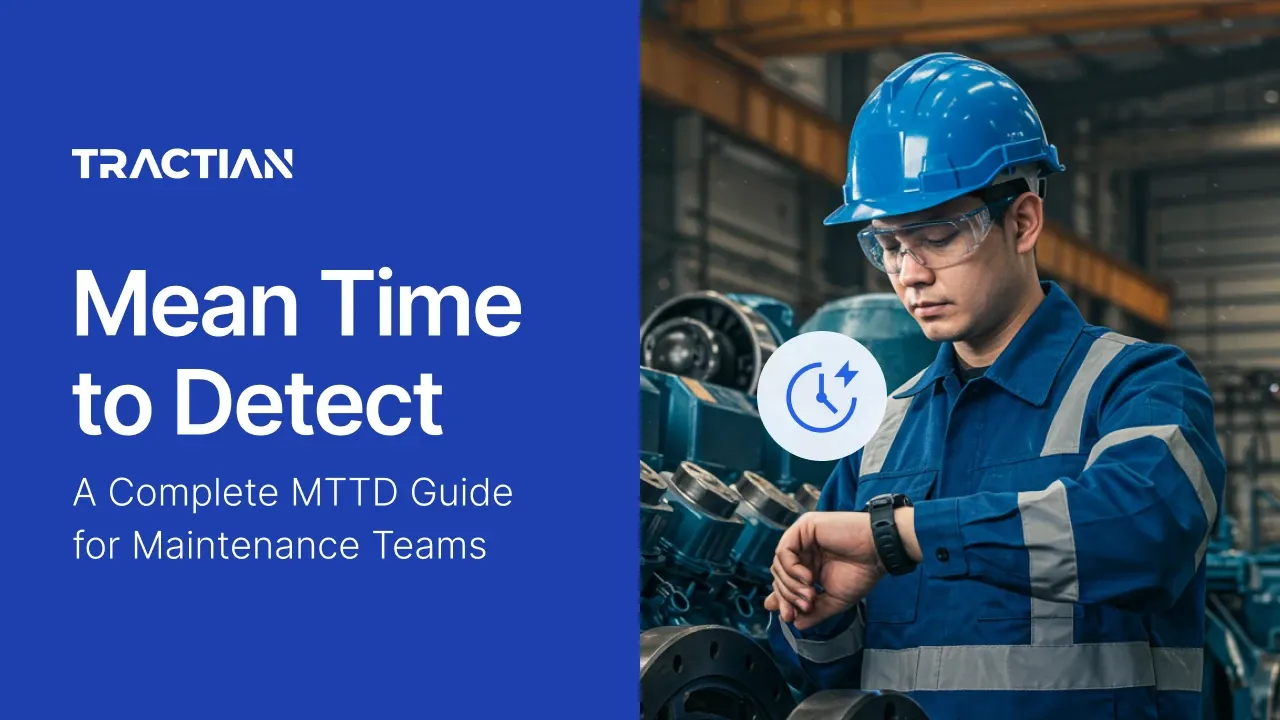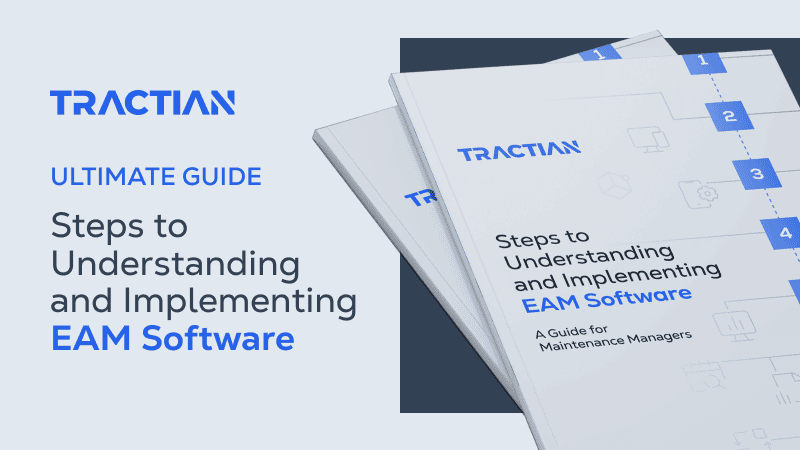If equipment fails during the night, significant damage can occur if it remains unattended and undiscovered until the morning shift. Though a familiar issue, delays in detection like this happen more often than most maintenance teams realize. In fact, the extent and frequency of detection delays result in millions of dollars in avoidable repairs and downtime for operations.
Mean time to detect (MTTD) was developed precisely to measure this detection gap. That gap, more succinctly, is how long problems go unnoticed after they begin. The faster you catch issues, the smaller and cheaper they are to fix. However, improving detection speed requires more than just desire or additional inspections.
To help you understand how MTTD can work for your operations, this guide will show you how to calculate mean time to detect, identify what's slowing down your detection process, and implement proven strategies that help maintenance teams catch problems before they become expensive failures.
What Is Mean Time to Detect (MTTD)
Mean Time to Detect (MTTD) measures the average time between when a failure occurs and when maintenance teams discover it. This metric tracks how quickly your team identifies problems, from the moment equipment starts failing until someone notices and logs the issue.
Picture this scenario: a bearing in your main production line begins to overheat during the night, but the issue isn’t noticed until hours later when the next shift arrives and hears unusual noise. In this case, there was a delay between when the failure occurred and when it was discovered.
When problems like this occur consistently across different failures, your MTTD metric tells you how long issues typically go unnoticed. Before we get into why this matters, let’s take a look at the metric itself.
The formula is pretty simple: MTTD = Total time between failures and detection ÷ Total number of failures. For example, if you experienced several failures with detection delays of a few hours each, you would calculate the average of those delays to determine your MTTD.
Every minute a failure goes undetected, the damage gets worse. What starts as a minor vibration can become a catastrophic breakdown if left unchecked. Unlike IT or cybersecurity contexts, where mean time to detect focuses on threat identification, maintenance MTTD specifically tracks the detection of physical equipment failures.
A failure event begins when equipment starts operating outside normal parameters, while time to detection starts when the failure occurs and ends when maintenance personnel identify and document the issue.
Why MTTD Matters for Maintenance Teams
If a critical pump at a chemical plant operates for an extended period with a failing seal before anyone notices, the repair costs can increase dramatically compared to those incurred when the issue is caught early. Simply put, fast detection prevents small issues from becoming expensive disasters.
However, the financial impact is felt in multiple ways and isn’t as simple. Longer detection times mean more secondary damage as failing components stress other parts of the system. A worn bearing that goes undetected can cause significant damage to the shaft, housing, and connected equipment, potentially resulting in a much more expensive repair than a simple part replacement. Applying bearing vibration analysis helps catch early signs of wear.
Faster detection also means shorter downtime windows, and predictive monitoring can reduce unplanned costs even more. When you catch a problem in its early stages, repairs are typically simpler, require fewer parts, and can often be scheduled during preventive maintenance windows rather than forcing emergency shutdowns.
Here's what reducing MTTD delivers for your operation:
- Lower repair costs: Early detection prevents minor issues from escalating into major component failures that require extensive parts and labor
- Reduced downtime: Faster detection means shorter interruptions because problems are addressed before they force complete equipment shutdowns
- Extended asset life: Catching problems early prevents premature equipment failure by addressing root causes before they cause irreversible damage
- Improved maintenance planning: Consistent detection times help with resource allocation by providing predictable windows for maintenance activities

This foundation of rapid detection becomes the cornerstone for transitioning from reactive firefighting to predictive maintenance strategies.
How to Calculate and Track MTTD
Calculating MTTD requires systematic data collection and consistent tracking methods that most maintenance teams can implement with their existing systems. The process involves three critical steps that build on each other to create reliable detection metrics.
1. Gather Failure and Detection Time Data
Accurate MTTD calculation starts with precise timestamps for both failure occurrence and detection. The actual moment of failure often differs from when someone first notices the problem. So you need multiple data sources to establish the timeline accurately.
Production logs, sensor readings, and operator reports help identify when equipment first started operating outside normal parameters. Temperature spikes, vibration increases, or pressure drops in historical data often reveal the actual start time of a failure, even if it was not immediately noticed.
The detection time is recorded when maintenance personnel first identify and document the issue. This could be during a routine inspection, when an operator reports unusual sounds, or when an automated alert is triggered. The key is consistency across your team when logging detection events.
2. Apply the MTTD Formula
The calculation itself is simple, but interpreting results requires context about your specific equipment and operating environment. A practical example can help you understand what the numbers mean.
Let’s say your facility experienced five failure events last quarter. Based on sensor data and log timestamps, you calculate the following detection delays: 3 hours, 6 hours, 1 hour, 4 hours, and 2 hours. Add those up (3 + 6 + 1 + 4 + 2 = 16 hours), then divide by the number of failures (5). Your MTTD is 3.2 hours.
That number now becomes a baseline. If the equipment in question is critical, like a recirculation pump in a solvent recovery loop, 3.2 hours might be far too long, given the risk of environmental or process impact. But if it’s a non-critical utility asset, that MTTD could be within acceptable limits. Context always matters when setting targets.
Always remember: good MTTD varies by equipment type and criticality, and organizations often set their own detection time goals based on the importance of each asset and their operational needs.
3. Use CMMS Alerts for Real-Time Tracking
Modern CMMS platforms automate much of the MTTD tracking process by timestamping failure events and detection activities. When properly configured, these systems capture the exact moment alerts trigger and when maintenance personnel acknowledge them.
Automated alerts eliminate human delay in the detection process. Instead of waiting for the next inspection round, condition-based alerts notify the right people immediately when parameters exceed normal ranges. This approach can reduce detection times from hours to minutes.
CMMS reports reveal patterns in detection performance across different assets, shifts, and failure types. You might discover that hydraulic system failures consistently go undetected for longer periods than electrical issues, or that night shift detection times lag behind those of the day shift.
Challenges That Slow Detection
Most maintenance teams face predictable obstacles that extend detection times. Identifying these bottlenecks is the first step toward faster response, and the most common delays stem from gaps in monitoring coverage and disconnected information systems.
Insufficient Automated Monitoring
Relying on periodic inspections creates inevitable detection delays because failures don't wait for scheduled rounds. If a bearing begins to fail between scheduled inspections, it may go unnoticed for an extended period, allowing damage to accumulate before the next maintenance check.
Human factors compound the challenge. Inspectors might miss subtle changes in equipment behavior, especially when they're rushed or distracted by other priorities. Even experienced technicians can overlook early warning signs if they're not looking for specific indicators.
Traditional monitoring approaches create blind spots between inspection intervals. Equipment can fail, partially recover, and fail again without anyone noticing the pattern. This intermittent behavior often signals serious underlying problems that periodic checks simply can't catch.
Fragmented Data Across Systems
When production data lives in one system, maintenance records in another, and sensor readings in a third, critical warning signs get lost in the gaps. An operator might notice unusual vibration, but if that observation doesn't reach the maintenance team until the next shift meeting, the detection time is unnecessarily stretched.
Data fragmentation also prevents pattern recognition. Temperature trends that would clearly indicate bearing failure when viewed together might seem normal when scattered across different systems and time periods.
Communication delays between shifts and departments add another layer of detection lag. When the operations team notices something unusual but doesn't immediately alert maintenance, the entire response gets delayed.
Common detection obstacles include:
- Infrequent manual inspections that miss failures between scheduled rounds
- Lack of sensor coverage on critical components that fail between inspection periods
- Poor communication between shifts or departments that delay information transfer
- Inadequate training on failure indicators that cause teams to miss early warning signs
- An overwhelming number of false alarms that cause teams to ignore legitimate alerts
3 Strategies to Reduce MTTD
Building faster detection capabilities requires a systematic approach that combines technology, processes, and human expertise. The most effective strategies address both the technical and organizational factors that influence detection speed.
1. Implement Predictive Maintenance Sensors
Sensor technology transforms detection from periodic snapshots to continuous monitoring, catching problems the moment they start developing. Vibration sensors detect bearing wear, temperature sensors identify overheating, and acoustic sensors pick up unusual sounds that indicate mechanical problems.
Different equipment types require specific sensor approaches. Rotating machinery benefits from vibration and temperature monitoring, while hydraulic systems need pressure and flow sensors. Electrical equipment requires current and voltage monitoring to detect developing faults before they cause failures.
The key is interpreting sensor data to distinguish between normal variations and developing problems. Baseline readings establish normal operating ranges, while trending analysis reveals gradual changes that indicate wear or degradation. This continuous monitoring reduces the time to detect from hours to minutes.
2. Integrate Real-Time Alerts and Notifications
Automated alerting systems eliminate human delay in the detection process by immediately notifying the right people when problems occur. Condition-based alerts trigger when sensor readings exceed predetermined thresholds, ensuring that developing problems receive attention before they escalate into failures.
Alert thresholds must strike a balance between sensitivity and practicality. Set them too low and you'll overwhelm the team with false alarms. Set them too high and you'll miss early warning signs. The best approach uses multiple threshold levels for different severity conditions.
Mobile notifications reach maintenance teams anywhere in the facility, eliminating delays caused by people being away from their desks or radios. Push notifications on smartphones or tablets ensure that critical alerts receive immediate attention, regardless of location.
3. Standardize Training and Procedures
Human factors play a crucial role in detection speed, even with automated systems in place. Maintenance teams need standardized procedures for equipment monitoring, clear guidelines for identifying failure indicators, and consistent training on detection responsibilities.
Training programs should focus on early failure indicators specific to your equipment. Bearing failures produce characteristic vibration patterns, pump cavitation creates distinctive sounds, and electrical faults generate specific heat signatures. Teams that recognize these early signs can detect problems before automated systems trigger alerts.
The combination of technology and human expertise creates the most robust detection system, where automated monitoring catches problems that people might miss, while experienced technicians provide context and judgment that sensors can't deliver.
Comparing MTTD With MTTR and Other Metrics
Understanding how mean time to detect fits with other maintenance metrics helps teams see the complete picture of their maintenance performance. Each metric measures a different aspect of the maintenance process, and together they reveal where improvements will have the biggest impact.
The relationship between MTTD and MTTR (Mean Time To Reduce Failure) reveals optimization opportunities. When MTTD is low but MTTR is high, you're finding problems quickly but struggling with repairs. When MTBF (Mean Time Between Failures) is declining while MTTD stays constant, your detection capabilities are stable, but your preventive maintenance needs attention.
Focusing on MTTD improvement often creates cascading benefits across other metrics. Faster detection typically leads to simpler repairs and less secondary damage, making MTTD a high-leverage metric for overall maintenance improvement.
Real World Insights From Maintenance Teams
Johnson Controls overcame detection challenges by implementing comprehensive monitoring solutions and saved $2.6M in total costs. "With the adoption of TRACTIAN solutions, the maintenance team at Johnson Controls can now detect and diagnose failures early on with increased accuracy."
Leading maintenance teams consistently demonstrate that detection improvement follows predictable patterns. Most organizations see initial MTTD reductions of 40-60% within the first six months of implementing automated monitoring, with continued improvements as teams refine their processes and thresholds.
The biggest gains come from eliminating the longest detection delays. It is generally more straightforward to make significant improvements in detection time when starting from a higher average than when working to further reduce already low detection times. Teams with consistently low MTTD spend less on emergency repairs, experience fewer production interruptions, and maintain higher equipment availability.
Successful implementations consistently show several key patterns:
- Detection consistency: Consistent detection is as important as speed because predictable response times enable better maintenance planning
- Equipment prioritization: Focus detection efforts on critical assets first, then expand coverage as capabilities mature
- Team collaboration: Cross-functional communication improves detection when operations, maintenance, and engineering teams share information effectively
- Technology integration: Combining multiple monitoring technologies creates better results than relying on any single approach
How Tractian's Condition Monitoring Can Transform Your Detection Speed
No matter how skilled your maintenance team is, getting consistent value from detection efforts depends on having the right tools and processes in place. Fast detection brings structure, visibility, and control to your maintenance operations, turning reactive firefighting into proactive asset management.
But when it comes to having the right tools, there’s a real challenge: most monitoring systems are either too complex to implement quickly or too basic to provide actionable insights. What you gain in complexity, you lose in practice when sensors generate false alarms, data stays siloed, and teams stop trusting the alerts.
Tractian's condition monitoring solution was built to solve exactly these problems. From day one, it delivers precise, actionable insights your team can act on with confidence. Vibration analysis, temperature monitoring, and automated diagnostics are clean, accessible, and designed to mirror the actual maintenance process.
Tractian's platform goes beyond simple alerting to provide context and recommendations. With patented AI failure detection, automated root cause analysis, and seamless integration with your existing workflows, you're not just detecting problems faster, you're preventing them entirely.
Getting started is simple, with onboarding and implementation designed to be fast and hassle-free. No lengthy IT projects. No weeks of training. You’re team gets a solution they can immediately use to catch problems before they become failures.
Ready to see it in action?
Request your free trial today and discover how Tractian's condition monitoring helps you build a more reliable, efficient, and predictive maintenance operation.



